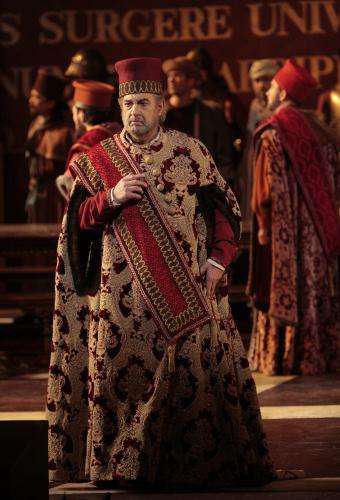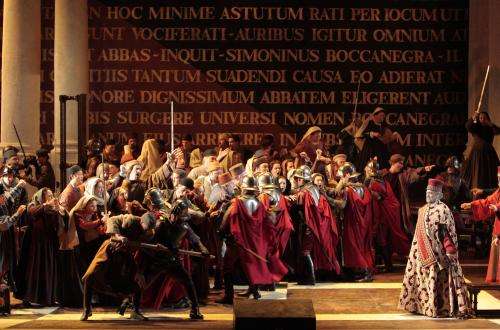|
Back
Long Live the Doge Los Angeles
Dorothy Chandler Pavilion
02/11/2012 - and February 15*, 19, 21, 26, March 1, 4, 2012
Giuseppe Verdi: Simon Boccanegra
Plácido Domingo (Simon Boccanegra), Ana María Martínez (Amelia), Vitalij Kowaljow (Jacopo Fiesco), Stefano Secco (Gabriele Adorno), Paolo Gavanelli (Paolo Albiani), Robert Pomakov (Pietro), Sara Campbell (Amelia’s Maid), Todd Strange (A Captain)
Los Angeles Opera Orchestra and Chorus, Roberto Cani (Concertmaster), Grant Gershon (Associate Conductor and Chorus Master), James Conlon (Conductor)
Elijah Moshinsky (Director), Michael Yeargan (Set Designer), Peter J. Hall (Costume Designer), Duane Schuler (Lighting Designer), Charles Currier (Fight Director)

(© Robert Millard)
With at least 138 operatic roles under his belt, the esteemed Plácido Domingo’s unsurpassed talent continues to soar. No stranger to Simon Boccanegra, he first established himself inside this mature Verdi work as Gabriele Adorno, but this time he drops a vocal notch to fill the shoes of the great Genoese magistrate in this exquisitely rendered production by Elijah Moshinisky.
Simon Boccanegra has a complicated, protracted constructional past. Giuseppe Verdi’s heavily darkened score contains a re-write spanning just under 25 years, ironically paralleling that of the opera’s Prologue and Act I. The prodigious tinta, laden with severe dramatic coloration, is a veined and portioned reminder of Il Trovatore, Don Carlo and Luisa Miller. Altogether, Simon Boccanegra is in a class by itself, delving into psychological depths and musical jargon that, up until its time, weren’t explored as intensively by the composer.

(© Robert Millard)
Father/daughter relationships is a strong Verdi theme, and Simon Boccanegra is no exception. Ana María Martínez has superbly crafted herself as the most credible Amelia with lyrical delicateness and captivating command of the challenging Verdi role. Despite the incalculable edges of vocal extremes, Ms. Martínez parlays the performance with effortless sustainability while preserving a conservatively dignified presence. Ana María Martínez is in top form, especially during her Act I aria “Come in quest’ ora bruna” while her duet with Simon (“Favella il Doge”) is splendidly executed.
One of the most memorable moments goes to debuting Stefano Secco as Gabriele Adorno. His articulation is polished and stalwart from beginning to end. Particularly radiant is his Act II aria “Perdon, perdon, Amelia” followed by a highly effectual and masterful blend of Domingo, Martínez, and Secco. Returning Vitalij Kowaljow’s Fiesco is rather subdued exhibiting a rich bass register although the low notes hit a soft spot which tends to get a bit muddled by the orchestra. From Paolo to Paolo, Gavanelli’s Albiani has exceptional uplifting vibrato, despite an ironic sheet for such an evil character.
The Los Angeles Opera Chorus unarguably shudders the stage during the momentous group scenes. James Conlon’s meticulous zest is evident as Mr. Allstate: “we’re in good hands.” The sets by Michael Yeargan are boldly minimal, yet intrinsically rich, anchored by a host of rarefied Romanesque columns reaching into infinity with occasional backdrops to change scenery in a snap with a remarkable aesthetic and economical flair. This Simon Boccanegra color pallet is undeniably tasteful, thanks to the blend of Duane Schuler’s sourced lighting (creating silhouettes which bring words to life) alongside stunning 14th century period dress by Peter J. Hall. The fit’s so pleasant that it doesn’t fight with the music, yet only enhances the remarkable Verdi score.

(© Robert Millard)
The opera would not be complete without a comment about the Council Chamber scene: it’s categorized as one of the pinnacle moments in Simon Boccanegra. In this production Moshinsky expresses it in layers of Patrician reds, Plebian browns, lit torches and chiaroscuro lighting that ultimately creates a Caravaggio-like painting. The collage is stunning.
Less evident is a the “cardboard cutout” quality acting. Charles Currier’s fighting isn’t palpable. Interventions, embraces, struggles and tussles appear a bit shallow. Nonetheless, this thinned hollowness is swallowed up by a team of powerful voices.
Christie Grimstad
|